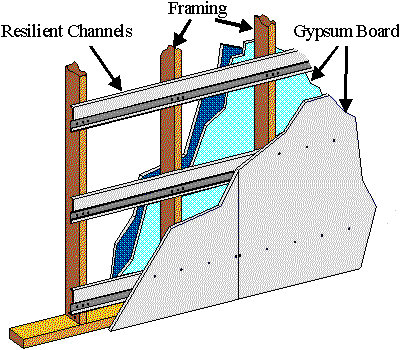![]()
Sound Isolation
It
is important to prevent sound transfer between certain spaces. Offices
need confidential privacy. Neighbors sharing common walls need to have a
reasonable degree of separation for basic comfort and privacy. Special
areas like movie theaters or recording studios cannot tolerate intrusive sounds
from other areas.
Sound
isolation is achieved by both proper wall selection and thorough attention to detail.
It is not just a matter of adding extra mass to the wall. The right
construction techniques must be used to get the maximum amount of
separation.
Walls
are rated in terms of the Sound Transmission Coefficient (STC). An STC 45
wall will stop about 45 decibels of airborne sound transfer from one space to
another. However, the STC rating does not address very low
frequencies. Noise insulation Class
(NIC) is the field version of the STC laboratory test.
For
residential projects, many state or local building codes require that walls
between dwellings be rated at STC 50 or higher. The International
Building Code (IBC) and the Uniform Building Code (UBC) both contain STC 50 and
IIC 50 minimum requirements between dwellings. However, not all building
departments adopt or enforce these sound rating requirements.
There
are also requirements for footfall noise resistance for floor/ceilings
expressed as the Impact Insulation Class (IIC) ratings. With
carpeting, almost any floor-ceiling system will be rated at IIC 60 or better. It is very
difficult to achieve IIC 50 with a hard surfaced floor, even with cushioned
vinyl. This is often a problem with kitchens and bathrooms, where using
carpet is not practical.
Caution:
Published STC and IIC ratings vary for any given wall
type. One popular single-stud / single sheet rock wall construction has
test reports showing every value between STC 42 and STC 51. However, the
average value is STC 46. If your project relies on one abnormally high
value, the chosen wall may not really meet the minimum STC 50 code requirement.
A wall that has a laboratory tested rating of STC 50
is never expected to perform better than STC 45 in the field -- even with
perfect construction technique. A five-point loss is considered normal
for real world versus laboratory conditions, and is even incorporated into the
building codes.
Details
and quality control are critical. It does little good to choose a wall
with a high sound rating, and then leave the perimeter and penetrations
uncaulked. In fact, a sound leak totaling only 1% of the total area can
degrade the overall sound rating by 15-20 decibels. One common example is
unsealed electrical junction boxes in a party wall, especially when they occur
back-to-back.
Conceptually,
think of flooding the wall with water. Wherever the water leaks out,
sound will also escape. These are the areas that need acoustical
sealant. Acoustical sealant is non-shrinking and non-hardening, so it
remains in place and pliable. There are special mastic pads available to
seal electrical boxes.
Here
are three common examples of sound isolation problems:
- Typical walls between offices
stop at the suspended acoustical tile ceiling. But ceiling tile is
porous to sound, and some sound travels over the open top of the
wall. If the wall stops at the ceiling line, the room-to-room rating
will not exceed STC 35, regardless of the wall's rating. After
performing hundreds of field tests, none have exceeded STC 35. Adding
a row of batts on top of the ceiling tile does nothing to improve
the STC value.
- Resilient channels (RC) can
improve the sound ratings of walls if used correctly. They are
especially effective with wood stud framing. RC channels work well,
but it is easy to install them incorrectly. We have seen RC channels
mounted upside down, attached parallel to studs, wedged into the edge of
the wall, pinned to the underlying structure, and just about every
installation problem imaginable. One common error is to put
resilient channels on top of an existing wall. The intent is to
improve the overall sound rating, but this simply does not work. It
is virtually impossible to prevent screw contact with the underlying
layer, which negates ALL of the acoustical benefit of the RC channels.
Also note that "hat" channels have no acoustical value, and are
not a substitute for resilient channels.

Given the problems with installation, we generally
prefer either light gauge metal studs or staggered wood studs for most sound
rated walls. Click here to download a one-sheet compilation of sound
ratings. wall comparison chart
A layer of "sound-deadening board" or sheet
rock, or a similar material is often used in the center space of a double stud
wall, between the stud rows. It seems intuitive that adding an extra
layer of material would improve the sound rating. However, dividing the
internal air cavity changes the resonances of the wall, with a serious loss of
performance. Without an open internal structure a double stud wall is
typically rated at STC 60. With an
inner layer, the rating drops to STC 46.
Sound-deadening board is too
lightweight to be a noise barrier, too rigid to replace a resilient channel,
but not porous enough to be an effective absorber. There are very few
situations where sound-deadening board has ANY useful acoustical
properties.